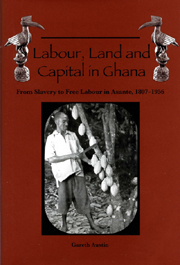Book contents
- Frontmatter
- Contents
- List of Illustrations
- List of Tables
- Preface
- Note on Names
- Maps
- Note on the Maps
- 1 Introduction
- Part I Context and Concepts
- Part II Social Relations of Production and Trade, 1807–1896: Absent and Imperfect Factor Markets
- Part III Slavery as Hobson's Choice: An Analysis of the Interaction of Markets and Coercion in Asante's Era of ‘Legitimate Commerce’, 1807–1896
- 8 Factor Markets Without Free Labour: The Nieboer Hypothesis and Asante Slavery and Pawnship, 1807–1896
- 9 Gender and Kinship Aspects of the Social Relations of Production, 1807–1896
- 10 Exploitation and Welfare: Class and ‘Social Efficiency’ Implications of the Property Rights Regime, 1807–1896
- Part IV The Decline of Coercion in the Factor Markets of Colonial Asante: Cocoa and the Ending of Slavery, Pawnship and Corvée, 1896–c.1950
- Part V Social Relations of Production and Trade, 1908–1956: Towards Integrated Factor Markets?
- Part VI Freedom and Forest Rent, 1908–1956
- Abbreviations Used in the Notes
- Notes
- List of References
- Index
8 - Factor Markets Without Free Labour: The Nieboer Hypothesis and Asante Slavery and Pawnship, 1807–1896
from Part III - Slavery as Hobson's Choice: An Analysis of the Interaction of Markets and Coercion in Asante's Era of ‘Legitimate Commerce’, 1807–1896
Published online by Cambridge University Press: 12 September 2012
- Frontmatter
- Contents
- List of Illustrations
- List of Tables
- Preface
- Note on Names
- Maps
- Note on the Maps
- 1 Introduction
- Part I Context and Concepts
- Part II Social Relations of Production and Trade, 1807–1896: Absent and Imperfect Factor Markets
- Part III Slavery as Hobson's Choice: An Analysis of the Interaction of Markets and Coercion in Asante's Era of ‘Legitimate Commerce’, 1807–1896
- 8 Factor Markets Without Free Labour: The Nieboer Hypothesis and Asante Slavery and Pawnship, 1807–1896
- 9 Gender and Kinship Aspects of the Social Relations of Production, 1807–1896
- 10 Exploitation and Welfare: Class and ‘Social Efficiency’ Implications of the Property Rights Regime, 1807–1896
- Part IV The Decline of Coercion in the Factor Markets of Colonial Asante: Cocoa and the Ending of Slavery, Pawnship and Corvée, 1896–c.1950
- Part V Social Relations of Production and Trade, 1908–1956: Towards Integrated Factor Markets?
- Part VI Freedom and Forest Rent, 1908–1956
- Abbreviations Used in the Notes
- Notes
- List of References
- Index
Summary
We have seen that slavery, slave trading and pawning were widespread in nineteenth-century Asante society and provided major inputs into the whole range of directly productive activities. This chapter analyses the causes, nature and results of this pattern of interaction between coercion and market forces in the acquisition and use of resources. Besides tackling a crucial aspect of the particular history of Asante social relations of production, this discussion is intended as a case-study in a wide-ranging controversy on which general positions have been strongly stated but which have been remarkably short on systematic empirical investigation. It includes the first attempt to quantify the cost of slave compared to free labour within a precolonial African society. From this analysis I will propose a simple model of the impact of coercion on labour markets in a land-surplus economy.
The classic economic interpretation of slavery, which we may call for generic convenience the ‘Nieboer hypothesis’, explains the existence of widespread slavery as a profit-maximizing response to a scarcity of labour in relation to land, in economies in which capital, however desirable, was not essential for subsistence (as it might be in pastoral societies). The most influential restatements of this tradition, both succinct, were published over a quarter of a century ago. Evsey Domar's 1970 paper was widely discussed by students of serfdom and slavery in Europe and the Americas. For the West African context the Nieboer hypothesis received its classic formulation in five pages by Tony Hopkins in 1973.
- Type
- Chapter
- Information
- Labour, Land and Capital in GhanaFrom Slavery to Free Labour in Asante, 1807–1956, pp. 155 - 170Publisher: Boydell & BrewerPrint publication year: 2005

